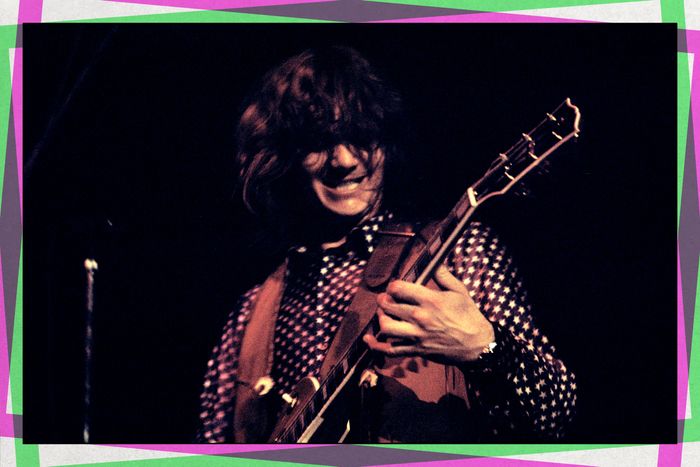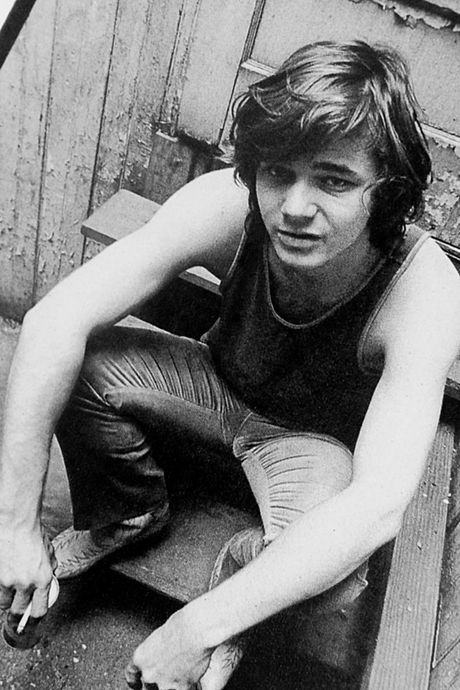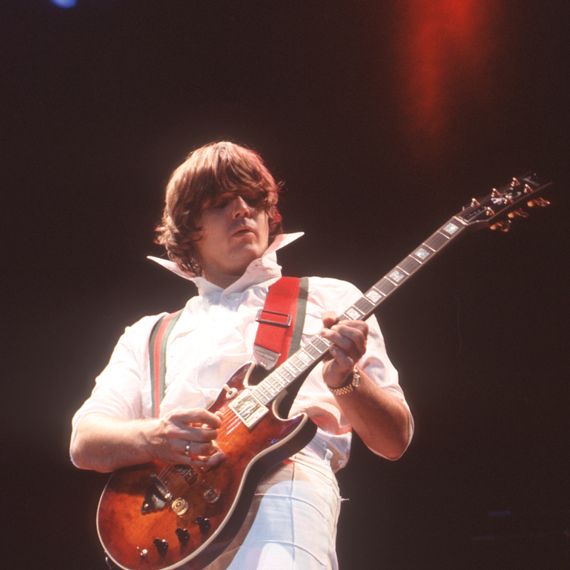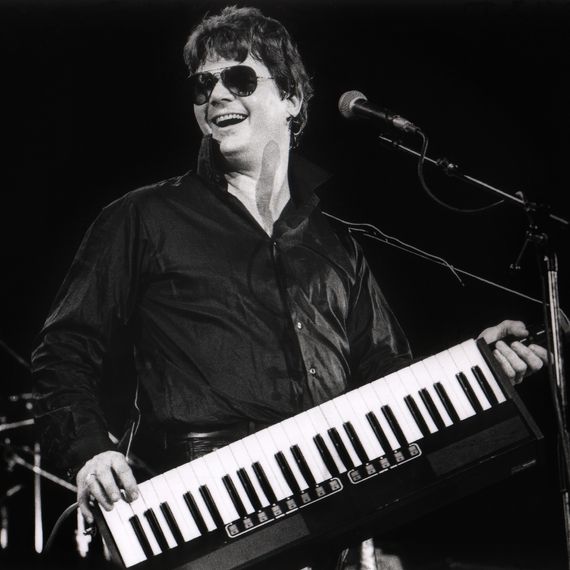
Even when hes singing about robbing castles or sinning, Steve Millers songs contain a sense of meticulous control. Maybe its due to the harmonies. Or how tight the guitars are. Or the groove. Or the musicality. Or  well, we could keep on hypothesizing, but the results are always the same: Miller has an uncanny sonic ability to honor the past while anticipating the future, ever since he and his eponymous band first emerged as radio whisperers in the late 60s. To study the scope of Millers impact is to study his geographical footprint. He began his blues and jazz education in Dallas as a kid and honed it in Chicago as a young man, only to embrace psychedelia when he moved out west to San Francisco. By the time Fly Like an Eagle and Book of Dreams smashed through in the mid-70s, he was even embracing life as the pompatus of pop.
In the present, IÔÇÖm speaking with a mellow and fulfilled Miller, whoÔÇÖs lived in upstate New York for nearly a decade now. The stomping grounds have made it easy for the singer-songwriter to be a visiting member of the Department of Musical Instruments at the Metropolitan Museum of Art, as well as craft a blues pedagogy for Jazz at Lincoln Center, where heÔÇÖll soon be performing two concerts exploring his legacy. ItÔÇÖs clear that Miller wants to keep rockinÔÇÖ for as long as the guitar gods will allow him, and he hopes he can inspire a new crop of working musicians in the process.
ÔÇ£ThatÔÇÖs what IÔÇÖm trying to teach ÔÇö how to put a band together and go on the road and entertain an audience to have them remember who the hell you are and come back to see you next year, and the next year, and then 30 years later, to build a career,ÔÇØ he explains. ÔÇ£IÔÇÖve somehow managed to do that, and I want to share that information with all these kids.ÔÇØ
Career-defining song
Well, I fear this is going to be the same answer to all your questions. [Laughs.] It would be ÔÇ£Fly Like an Eagle.ÔÇØ It was a time when I really matured as a writer and I started writing much better songs. I was developing my music. Things that I had been working on for a long period all came together. ÔÇ£Fly Like an EagleÔÇØ is a combination of electronic music and a really funky groove. I put in some socially conscious lyrics and an inspirational message ÔÇö at least, I hope people think itÔÇÖs inspirational.
IÔÇÖm thinking in terms of culmination. I started playing professionally when I was 12 years old. I was in a real band and we were playing all the time. At that point, it was kind of three chords and some blues songs. I grew up in Texas. It was all pretty simple and straightforward. But as I aged I learned more music, got more experience on the road, and then went through college. I spent some time in Chicago with ÔÇ£mature menÔÇØ like Muddy Waters, Junior Wells, Buddy Guy, and James Cotton ÔÇö that was a really important period for me. I also spent some time in San Francisco, and that was a very experimental time. You could do anything you wanted to do. Anything.
So when I was playing blues and rock and roll, I was listening, of course, to jazz, but I also loved electronic sound effects. I was trying to figure a way to incorporate all of that into a form of music that you could play on the radio, but wasnÔÇÖt so esoteric that no one would listen. That was the goal. It took some convincing and some work with the engineers and the record company. Once I got it formulated in my mind, it took about three years of traveling, touring, and playing that to develop what we now think of as ÔÇ£Fly Like an Eagle.ÔÇØ There were two or three different versions of it along the way. I rejected lots of verses, lots of ideas, and lots of different segments over this period of playing it live. Back in those days, we used to play for three or four hours each night, and we were basically touring and playing at what I call ÔÇ£psychedelic dungeons.ÔÇØ Old dance halls, old theaters, stuff like that. There would be a mirrorball in the ceiling with a spotlight on it. That was about it for the light show. We did 200 shows a year, and that was the song that lasted on our set list the longest.
Nerdiest song for gearheads
ThatÔÇÖs a funny question. I wish I had a list of all my songs in front of me. When we started recording, we went to London and we recorded at Olympic Studios, a very famous studio in London. We started working with Glyn Johns. We sort of learned the ÔÇ£English approachÔÇØ to recording, and that got to be a big part of our regular working system. We would go in and cut a bunch of tracks, we would think about it, and then we would start doing guitar work. ThatÔÇÖs where it got nerdy ÔÇö when it was time to start doing solos and figure out harmony parts for the vocals. It didnÔÇÖt sound nerdy, but the actual work itself was time-consuming and made me into a horrible perfectionist for quite a while. It was later when I started engineering my own stuff that I got much more relaxed.
So, letÔÇÖs say anything from Sailor. HereÔÇÖs a story for you. ThereÔÇÖs a song called ÔÇ£Song for Our AncestorsÔÇØ that opens the album. We wanted to have whatÔÇÖs now known as the loop ÔÇö but back then there wasnÔÇÖt the name for it. I wanted a vocal chorus in the background. I sang it, we took it, and we actually turned it into a physical loop. I was about 20 feet away from the tape recorder holding a pencil. That was about as far out as it got. The tape was running through the tape recorder, going around the pencil, and then back into the tape recorder to make the opening chords on that particular instrumental. I was sitting over in the corner holding the pencil still, so the tape would roll around the pencil and the tape recorder would pull the tape back around. That kept the sound going. Of course, it was a little wobbly, but we thought it was great at the time. But it wasnÔÇÖt good enough to patent!
Song that required the most patience to write
Oddly enough, ÔÇ£AbracadabraÔÇØ was a piece of music I had been fooling around with for a long time. It started as an instrumental, gypsy-blues kind of tune. I wrote this really bad set of lyrics and recorded it. I was going to put it on an album ÔÇö I canÔÇÖt even remember which album ÔÇö and right at the last second I said, ÔÇ£No, no, no, no, no. Wait, take that off. It can be a lot better.ÔÇØ So we took it off. For several more years, I thought about it and I just couldnÔÇÖt get the bad lyrics out of my head. They rhymed terribly and they were just engraved in my brain. But one day when I was out skiing, I saw Diana Ross out on the mountain and later in another room at a resort eating lunch. I sat down and I started thinking about the Supremes, who I played with when I was a kid back in 1965. I did Hullabaloo, which was a big national TV show, and the Supremes were also on it. I had seen them in person then. So I sat down after skiing, thought of the Supremes, and came up with the new lyrics in 12 minutes.
IÔÇÖve never had a chance to see Diana since then. IÔÇÖd tell her that they were very inspiring when I was a kid and I saw them play on Hullabaloo. They were magical. I loved Motown, of course. I could see the Supremes doing ÔÇ£AbracadabraÔÇØ very easily.
Song with the unlikeliest inspiration
Usually, theyÔÇÖre all inspired by music or lyrics, so I canÔÇÖt think of anything thatÔÇÖs really unlikely. They all seem to be part of the work I normally do. Songs have different purposes. I always liked the idea of making singles. Singles are like a puzzle that you put together and they need to have five elements. It has to have a really quick introduction that captures your imagination, because this was all back during the days of AM radio ÔÇö thatÔÇÖs how youÔÇÖve announced your arrival. You have to get out of sleep. The competition was brutal. You were in competition with anybody and everybody to get into the top 10, the top 40, or whatever.
How do you have a great chorus? You got to have a quick story thatÔÇÖs easy to understand. You got to have a really great opening. You got to have some sort of musical hook. ÔÇ£The JokerÔÇØ was my first really successful No. 1 single. There was no doubt about it. It had that funny opening with the slide guitar part. It had a chorus that everybody could sing. ItÔÇÖs got the story, itÔÇÖs got the character. That would be a good example of that type of song; the puzzle is finished.
I always wanted my albums to be hard to take off. Once you put them on, I want you to enjoy everything. There would be other pieces of music that would make the singles stand out. They would be almost like segues. ThatÔÇÖs where a lot of my segue work and my electronic ideas came into play. ÔÇ£ThresholdÔÇØ is the intro to ÔÇ£Jet AirlinerÔÇØ and enhances it. Things that set up songs that were singles so that you had a variety of music on a record. It wasnÔÇÖt just 12 singles in a row, kind of like one, two, three. You could relax. The musical horizon would be expanded, so it was really wide and interesting. Then something would come up that would capture your fantasy. That was sort of the ideal.
Most impulsive song
Oh, gosh. Maybe ÔÇ£Shu Ba Da Du Ma Ma Ma Ma.ÔÇØ No, itÔÇÖs ÔÇ£Space Cowboy.ÔÇØ That was a really quick one. That was a song I just made up. We did it really, really quickly in the studio. I didnÔÇÖt want to put it on the album. I wanted to take it off. Everybody while we were mixing told me, ÔÇ£Are you crazy? You want to toss it off?ÔÇØ And here I am, 55 years later, still a space cowboy. I thought it sounded a lot like ÔÇ£Lady Madonna.ÔÇØ It just sounded kind of familiar. We were just jamming and goofing around. It was something that I never really gave much thought to, letÔÇÖs say.
Song that exemplifies your pedagogical spirit
It would be all of the T-Bone Walker tunes and Jimmy Reed tunes that IÔÇÖve done over the years. For me, those were songs that I just loved instinctively as a child. T-Bone was a family friend and taught me a bunch of guitar licks and tricks when I was 9 years old. Then I started playing Jimmy Reed tunes and actually backed him up when I was 14 years old. I was playing music that I loved. At the time, I didnÔÇÖt realize T-Bone Walker was the bridge from blues to jazz and that Jimmy Reed was one of the greatest all-time blues musicians ever. He affected everybody all over the world. He doesnÔÇÖt get the credit that he deserves. Now, IÔÇÖm singing Jimmy Reed lyrics on top of jazz arrangements. ItÔÇÖs just phenomenal how it all goes ÔÇö you start learning the history of where this all comes from, how it develops, and how it grows into something new.
When I think of my music process, it has a lot of different elements. It has a lot of jazz. It has a lot of blues. It has lots of four-part harmonies. It has a lot of guitar work in it. So there are different sections, selections, parts, and pieces. I want to teach musicians how to perform. Up until the pandemic, we were doing 70 cities a year, every year, for the last 50 years, with only a few periods of time off. ThatÔÇÖs a big part of what this is all about ÔÇö performing and working with your audience, or keeping your audience in mind.
Most underrated album
Most of them. [Laughs.] Not really. I donÔÇÖt know. It might be Number 5, which was kind of a country-music album that I did in Nashville. It was fun and different, but it was still pretty successful. It sold around 400,000 copies. ThatÔÇÖs a pretty good batch of records back in the day. Actually, a great record thatÔÇÖs even more underrated is Italian X Rays. I forgot about it. That was the very beginning of digital recording. We were the first group at Capitol Records to use the digital tape recorder. It was a very experimental kind of record. That one came out and just sort of disappeared. But itÔÇÖs got some great songs on it.
Most prolific year of songwriting



It would be a few years, from 1973 to 1976, when I was extremely prolific. I wrote more No. 1 hits later, but that was a batch. That was about 25 really good songs that lasted forever. My process is that it usually starts with a guitar and IÔÇÖll have a musical idea. I love to play guitar ÔÇö I could sit and play guitar for two hours every day. I listen to these ideas musically and then IÔÇÖll start thinking about lyrics, and putting things together, and trying to get the whole concept or the idea into about a dozen songs. Where is this going? What is this about?
Favorite gem unearthed while curating your vaults
I was ready to throw it all out, but my wife convinced me otherwise. She would be like, Oh, come on. Lets go to the warehouse and listen to stuff you did 40 years ago, and I would be like, Nah. [Laughs.] My thought about it was like  Look, when I make an album, I know what Ive written and I know what Ive done. When it came time to put something out, I took the best that I had. If I didnt put it out, I dont particularly want to go back and listen to it. Yet, my mind has been consistently blown with what weve found and listened to. It puts things into perspective. For example, my wife found a whole lot of recordings from the early 70s that are just amazing. We were playing so well and I had no idea.
One of the things that she found was another studio version of a song called ÔÇ£Industrial Military Complex Hex.ÔÇØ We just love it. It was one of those songs that just was out briefly and disappeared, but then we were jamming and it got a lot better after we recorded it. We recorded it too soon, you know? ThatÔÇÖs one of the things about material ÔÇö you like to let it age, grow up a little bit, be able to think about it, and not have to do it too quickly. This one really got better later. When my wife found it I went, ÔÇ£Wow, who is that?ÔÇØ She said, ÔÇ£Well, honey, I mean, thatÔÇÖs you.ÔÇØ Oh! ThatÔÇÖs really cool.
IÔÇÖve had a lifetime of playing music. There have been different stages of my performance, my writing, my career, and the musicians that IÔÇÖve worked with. I actually have recordings of mine from 1957 and 1958. ThatÔÇÖs a large body of music. When you go back and listen to it all, it changes your perspective on when you were really good, when you were right on the money, when you were a little lost, when you were maybe looking and searching, and other times when you just had it. The magnificence of it all is really great. We were bad to the bone in the early ÔÇÖ70s.
Current status of your feud with the Rock and Roll Hall of Fame
IÔÇÖve pretty much put it behind me. I got so many phone calls from strangers and letters from people I didnÔÇÖt know wanting to talk about it. One guy had a pile, one-foot high, of documentation about the Hall of Fame. I looked at it. I think the Hall of Fame is getting a little bit better. ItÔÇÖs very different for every year that they put the ceremony together. The year I was inducted, I think they were just making a television show and didnÔÇÖt care about us at all. It was really not a pleasant experience. It means so much more, I think, to the world, than to the people who actually were running it.
ThatÔÇÖs why I was fairly upset with the stuff that I went through with them. We werenÔÇÖt even introduced to each other, the inductees. They never got us together. They never asked us to help them do anything or mentioned any of their programs. Their whole thing was, ÔÇ£Get your ass up there, get off the stage, weÔÇÖre making a television show. Go sit in that room on that metal chair, weÔÇÖll call you when we want you up. If youÔÇÖre not on, youÔÇÖre off. Good-bye.ÔÇØ It was unbelievably rude and uncharacteristically cold. I felt really bad. I felt bad for everybody that was inducted that night. But when you saw the show, it just looked like everybody had a great time. They were really good at cutting and editing. But I think itÔÇÖs getting better. I think theyÔÇÖre growing up a little bit. ThereÔÇÖs so much more that they could do, besides just being the snooty rock-and-roll place where their favorite people get eulogized. They could do a lot more teaching; they could do a lot more work. I never heard from anyone at the Hall after that. It was just like, next. I wouldnÔÇÖt be interested in working with them.
A perfect example would be to compare it with Jazz at Lincoln Center. One has taught 40,000 students. ItÔÇÖs got active programs all the time and is constantly teaching, expanding, and making a difference in peopleÔÇÖs communities. I would love to have seen the Rock and Roll Hall of Fame do something like that. But, yeah, IÔÇÖve pretty much moved on. I have other things to do.
How Merriam-Webster should define the term ÔÇ£pompatus of loveÔÇØ
ItÔÇÖs a word that has grown. It came from a different word and itÔÇÖs always changing. The meaning is up to the user. ThereÔÇÖs no actual definition. Can I even define it myself? Absolutely not. [Laughs.] I always think of something funny when ÔÇ£pompatusÔÇØ comes up. I was talking to Paul McCartney one time about writing. HeÔÇÖs such a great writer. He told me, ÔÇ£If it rhymes and if it works, it works. DonÔÇÖt worry about it.ÔÇØ It was kind of a relief to hear that it didnÔÇÖt all have to be absolutely brilliant. It was just something that popped up. I have probably received a hundred letters from lawyers asking me what the word means, because those lawyers want to know and define it themselves. ItÔÇÖs just weird. ItÔÇÖs one of those things. What the hell does it mean? The fact that nobody really knows what it means makes everybody curious about it. Good luck trying to find out.
More From The Superlatives Series
- Cyndi Lauper on the Freest and Most Provocative Music of Her Career
- The Best and Nastiest of Slipknot, According to Clown
- Seth MeyersÔÇÖs Proudest Milestones and Wisest Comedy-Writing Hacks


